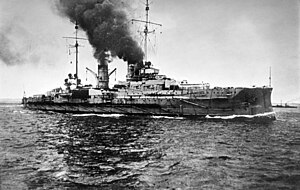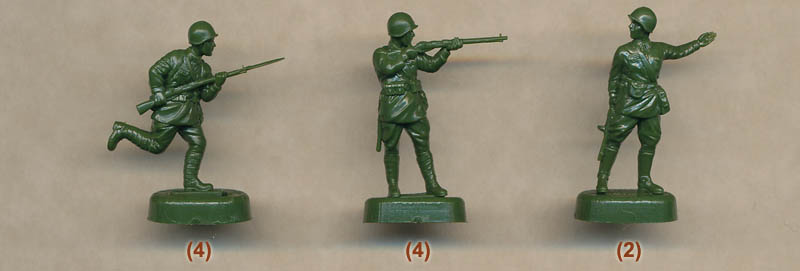
The Russian Coastal Defence Battleship Admiral Ushakov
I must apologise in advance for the fact that there are currently no pictures accompanying this post - other than the one above - because I am having some minor technical issues preventing me from uploading any. This should be resolved on the morrow and so a photo-essay style second part will follow in due course.
Last night saw the collection of the Stonewall Figures - My Little Ships models from Mr Fox and so these are now safely at anchor on my modelling tray. I was very pleased to get my hands on this little lot and so the plans in hand for my WW1 era set up are now moving, at the risk of being clichéd, at full steam ahead. The range is limited but the gaps can readily be filled from other manufacturers - I fully intend adding in some C in C models and some from Viking Forge in due course. C in C models are available in the UK from Wargames Emporium - C in C whilst Viking Forge can be obtained from Viking Forge - Minifleet in the US of A. As far as I know these are not available from any suppliers in the UK which is a shame as the range is very interesting.
The Stonewall models are basic and my oft-quoted analogy of them looking like 1/3000th models on steroids is a pretty good one. I should further qualify that by stating when I say 1/3000th models I mean old 1/3000th models....
They are not going to win any prizes for detail although some of them are very nice little models. On balance I would say that the Germans are the better range in terms of cleanness of casting although the castings of the battleship Baden and the armoured cruiser Scharnhorst are pretty rough. I am quite sure though that a lick of paint will soon have them looking suitably resplendent and ready for action. To give you an idea of the collection size take a look at the following:
Royal Navy
1 x Tiger - Battle Cruiser
3 x Lion - Battle Cruiser
3 x Iron Duke - Battleship
6 x Orion - Battleship
4 x KGV - Battleship
4 x Bellerophon - Battleship
4 x Bristol - Light Cruiser
4 x Chatham - Light Cruiser
12 x M Class - Destroyer
High Seas Fleet
2 x Derflinger - Battle Cruiser
3 x Baden - Battleship
4 x Konig - Battleship
4 x Kaiser - Battleship
5 x Helgoland - Battleship
4 x Westfalen - Battleship
2 x Scharnhorst - Armoured Cruiser
5 x Breslau - Light Cruiser
1 x Konigsberg - Light Cruiser
21 x T class - Torpedo Boats
The Royal Navy battleships have suffered somewhat from the battered tripod mast syndrome - many of these are missing the fighting tops although removing the residue and replacing them with wire pole masts would work pretty well - most of them are destined for service in fictional navies so some change in appearance will help in that respect. The KGVs are the best of the bunch as all them are fully intact in this respect; the worst offenders being the Orions. The smaller models are very nice indeed and so buying these models cheaply and using more expensive and better detailed larger models is probably an option.
The models I have will be more than sufficient for the capital ship requirements for the four fleets under consideration but expenditure will be required to finish them off. Luckily this will not be too excessive and is limited to early battle and armoured cruisers and some more destroyers.
I also took delivery of a selection of Viking Forge pre dreadnought era warships that will serve to provide much of the older navies for both Fezia and Rusland. This little lot came from the Area 51 (in this case the garage) of Mr Hardman. The models are very nice indeed and also feature separate gun turrets for some of the larger ships - I am not sure if that is a good idea for me and so these will be fixed firmly in place when I get to them! The collection consists of the following:
Austria
3 x Wien - Old Battleship
Germany
3 x Pommern - Pre-Dreadnought Battleship
2 x Nymphe - Protected Cruiser
Japan
2 x Fuji - Pre-Dreadnought Battleship
1 x Mikasa - Pre-Dreadnought Battleship
2 x Shikishima - Pre-Dreadnought Battleship
1 x Asahi - Pre-Dreadnought Battleship
2 x Nisshin - Armoured Cruiser
1 x Chiyoda - Protected Cruiser
1 x Suma - Protected Cruiser
1 x Chinen - Coastal Defence Battleship
4 x Murakumo - Torpedo Boat
Russia
3 x Admiral Ushakov - Coastal Defence Battleship
1 x Pallada - Armoured Cruiser
6 x Boiki - Destroyer
6 x Puilki - Destroyer
The great thing with this scale is the fact that the smaller vessels are more viable than in 1/3000th - especially important for somebody as ham-fisted as I usually am!
There is a lot of material to be working with here and I am going to spend the next few days finalising exactly what I want to do and how I want to do it. I also need to think about the new models that will need to be acquired and the painting of the same.



